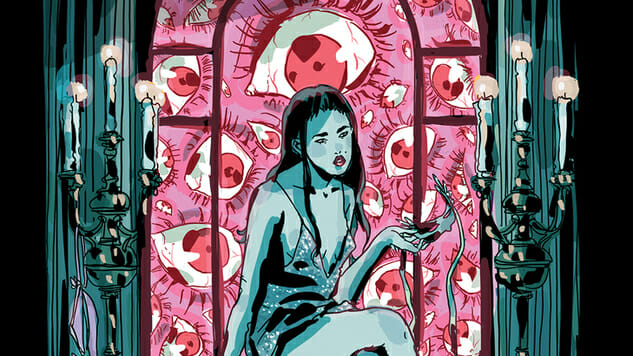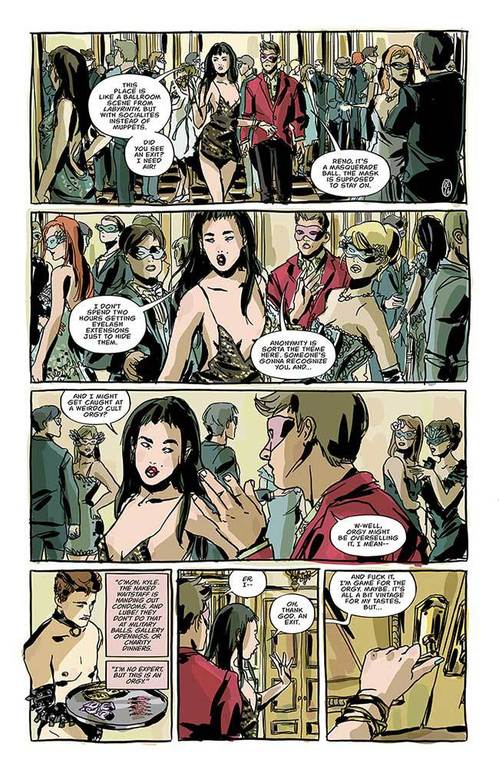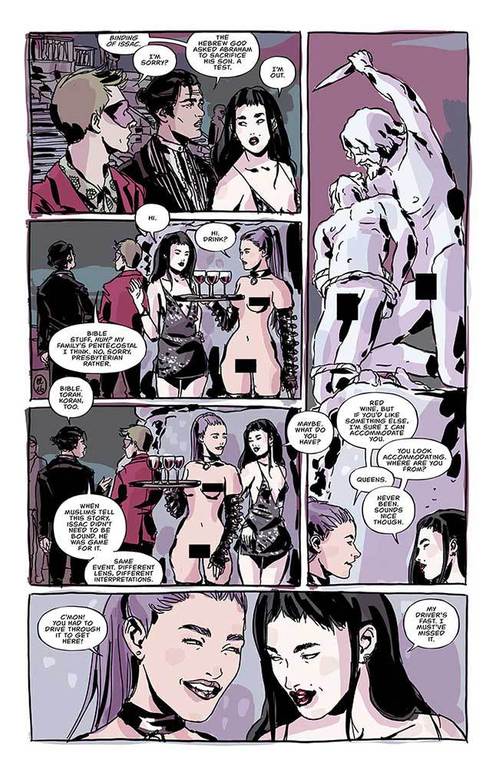Patrick Kindlon Exposes the Horrific Cost of Fame in There’s Nothing There with Maria Llovet
The Drug Church/Self Defense Family Singer Tackles Toxic Celebrity Culture in New Black Mask Horror Series
Main Art by Maria Llovet
What passes for horror in the comic world is too often just a shower of red ink and meticulously drawn viscera. There’s Nothing There, Drug Church vocalist Patrick Kindlon’s solo writing debut following his partnership with Matthew Rosenberg on books like We Can Never Go Home and S.H.I.E.L.D.: Quake, eschews gore for a much more sinister mounting tension. Socialite Reno Selleti flits comfortably through the world of paparazzi flashes and nonstop Instagram selfies with fans, until a hedonistic Hollywood party turns out to wield genuine occult power, giving Reno the ability to see apparitions with one message: run.
 Drawn with equal flair for bright-lights glamour, steamy sexuality and terrifying unease by European artist Maria Llovet, There’s Nothing There taps into the ‘60s and ‘70s paranoia-horror of Rosemary’s Baby as filtered through today’s hyper-aware celebrity culture. In advance of the first issue, which hits shops this week, Paste chatted with Kindlon about his own relationship with fans, the power of conspiracies and his decision to take a more public role in his writing career.
Drawn with equal flair for bright-lights glamour, steamy sexuality and terrifying unease by European artist Maria Llovet, There’s Nothing There taps into the ‘60s and ‘70s paranoia-horror of Rosemary’s Baby as filtered through today’s hyper-aware celebrity culture. In advance of the first issue, which hits shops this week, Paste chatted with Kindlon about his own relationship with fans, the power of conspiracies and his decision to take a more public role in his writing career.
![]()
Paste: Before orgies and ethereal horror, There’s Nothing There seems most concerned with the nature of celebrity. You’re the singer of a well-regarded band, but not necessarily in the sort of scene that inspires rabid, selfie-taking fandom. What drew you to create a celebrity socialite like Reno? Are you at all tuned into the Kardashian-esque realm of fame-for-fame’s-sake?
Patrick Kindlon: I’m the absolute lowest level of celebrity. Dudes who take paternity tests on Maury are higher-profile than I am. But, I still get recognized. And it’s always nice. It’s someone saying something kind. Picking up my meal for me. Or trying to buy me a drink. It’s about as healthy a “celebrity” as I can imagine for myself.
But I sometimes think about people who don’t get one friendly fan per week approaching them, but hundreds of entitled fans who have definite expectations of who you are and how you’re supposed to engage them. And it seems like a nightmare. Literal nightmare, where people are grabbing you or refuse to leave your space. I wanted to tell a story about that. Not as a polemic where I’m lecturing about the darkness of fan culture, but as a conversation with myself. Being famous seems cool when you want free pizza or anonymous sex. Seems like a pain in the ass when you just want to pick up some mangos at Whole Foods without people swarming you.

There’s Nothing There #1 Interior Art by Maria Llovet
Paste: While we’re on the subject of your music—what’s on the playlist for There’s Nothing There? Can you write to music with lyrics, or do certain songs just help to put you in the mood and mindset for the book?
Kindlon: I can listen to music when I’m thinking about a book. Can’t listen when I’m writing one. I prefer YouTube field recordings and things like that. When I’ve been staring out into space thinking about this series, I’ve gone back and forth between shallow and dark. Big-room house music from artists with one-word names I don’t remember, or Bill Fay. Very little in-between. Depeche Mode might be the place these sensibilities meet. Often glossy and meant for quick consumption, but also heavy and upsetting. That might be the right thing for a reader to listen to while reading. Or, fuck it, go listen to The Crow soundtrack. It’s everything laughable about an era, but so perfect in that role.
Paste: I’ve found that horror creators love to discuss their genre influences. There are no particularly obvious horror tropes in the first two issues of There’s Nothing There but I picked up the “simmering madness” vibe that you find in Shirley Jackson, Roman Polanski and some Lovecraft contemporaries. Did any horror influences leave a particularly large mark on your approach to the book?
Kindlon: Don’t Look Now, the Roeg movie, was in some ways the inspiration for this now that I think of it. I had been going down a hole of ‘70s crime movies and decided to jump over to horror for some variety. Don’t Look Now made such an impression on me for how it’s totally unafraid of being “off.” Its pacing is like being chased and then getting tired and hiding, then being chased again. Mundane and exciting trading blows for 100 minutes. The aesthetic is somehow over-the-top and totally staid at the same time. Like a messy zoom in a home movie. And the creepy bits are comfortable being unresolved. You’re watching it saying, “Is that just for the creepy factor, or is this gonna tie back to the theme?” and you really don’t care what the answer is.


